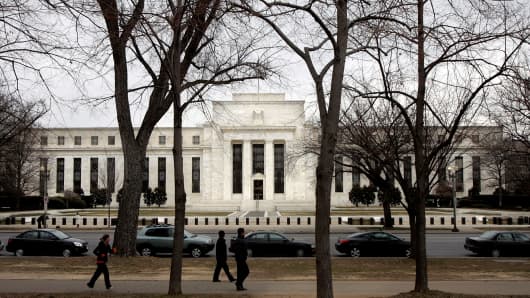How does Sumner know that demand for base money is still so high? Well, here's where his argument gets a little bit circular and annoying. We know demand for base money is high because growth is low despite the rise in base money. Low nominal growth in the face of a growing monetary base must indicate that demand for base money is rising even faster, in Sumner's model. Basically, as long as growth is low, monetary policy is too tight, according to Sumner.
What makes this circular and annoying is that demand for base money is simply a Higgs boson particle: something that we can't directly observe but we assume is there because without it nothing else we think we know makes much sense. So Sumner knows that base demand must be increasing if growth is below target while base supply remains steady or increases because that's the thing that would explain below target growth.
Sumner thinks the Fed could "loosen" policy by announcing that it would grow its quantitative easing program by 20 percent each month until growth returned to its target. I think that's right—but only if the Fed made a dramatic change in what it buys.
(Read more: Is there a natural revulsion to unconventional monetary policy?)
You see, Sumner is still thinking too conventionally. He uses a very standard definition of the monetary base. Basically, it's the sum of currency in circulation, plus deposits held by depository institutions at Federal Reserve Banks. In other words, wallet money plus vault money plus bank reserves.
This definition of the monetary base may be very useful for a lot of purposes. But in terms of trying to determine the stance of monetary policy, it results in a lot of confusion. It's far better for this purpose to instead to think of base money as including not just currency plus reserves but also Treasury bonds held by banks and the public, and well as the debt issued or backed by government-sponsored entities (primarily Fannie Mae and Freddie Mac). There may even be room for including in what I'll call the Policy Base triple-rated corporate debt.
The reason for this expansive definition is simple. In an economy with a financial sector as large and important as ours, these debt instruments perform money-like functions. They can be used to finance purchases of assets, collateralize liabilities, and settle payments. Anything that the market considers a "safe-asset" has a moneylike quality in a financial economy such as ours.
Once you define the Policy Base this way, several interesting things become clear. For one thing, the crisis of 2008 starts to look like a monetary contraction. Many of the assets that were formerly money-like—triple-A rated mortgage-backed securities, GSE-backed bonds—suddenly were deemed less "safe." Which is to say, they dropped out of the policy base. This means that the base was contracting in 2008. This contraction was somewhat ameliorated when the GSE's were placed into conservatorship. But even then the depressed production of mortgage-backed securities kept the base from fully reflating.
(Read more: Here's why people fear Fed policy (even though they shouldn't.)
This somewhat obviates the need to lean on a Higgs-Boson concept of base money demand. It's not impossible that demand for base money would shift and cause economic turmoil. But we no longer need that concept to explain, for example, 2008 as a monetary contraction.
The Policy Base view of monetary policy also explains why the Fed's asset purchases have not had more effect—and shouldn't be expected to. The Fed is essentially swapping some Policy Base assets for another—buying long-dated Treasurys or GSE-backed bonds. This doesn't grow the Policy Base at all. It simply shifts around its make-up. That can be expected to effect the relative values of Policy Base components but not do much for the broader economy.
A more effective quantitative easing would have to concentrate on buying non-Policy Base assets. Those would include riskier corporate bonds, non-GSE mortgage-backed securities or, even, real property. There would be other risks attendant in this (do we want the Fed to become a giant land-owner or investor in corporate America?). But it would grow the monetary base.
Another way to grow the Policy Base in this model is through deficit spending. Here's how that works. The government issues bonds in exchange for dollars, which is a Policy Base neutral action in this model because its just a swap of one policy base asset (dollars) for another (Treasury bonds). But then it spends the dollars back into the economy, resulting in a growth of the base more or less equal to the deficit.
Finally, the Policy Base can grow due to private credit expansion—so long as the bonds issued are considered relatively safe. Actually, even riskier debt can count toward the Policy Base, as long as it is properly discounted and not so risky that it cannot be used to fund other investment.
Notice that lately we've seen the deficit falling and little private credit expansion. Which means the Policy Base is shrinking again. Money is getting tighter. Which means our potential for economic growth is shrinking.





